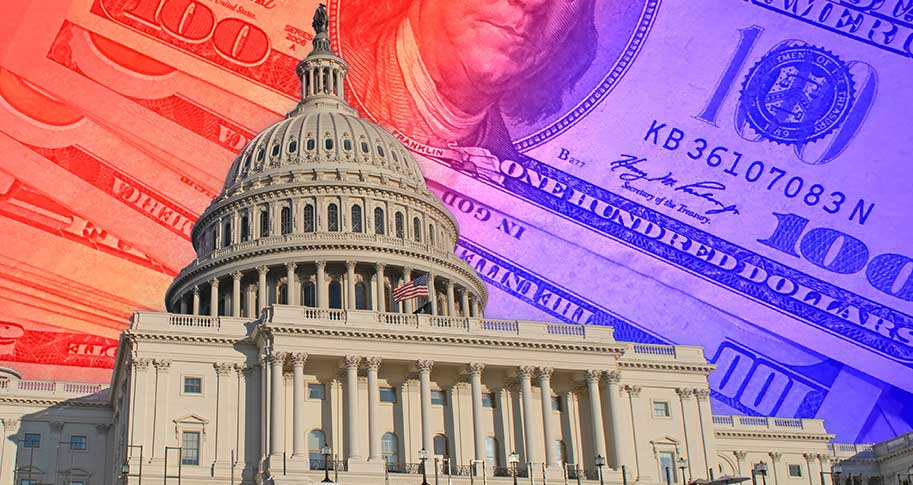
Corporate political activity (CPA), broadly defined as the relationships between business firms and government, has long held the interest of stakeholders beyond academia. But research on CPA has yet to include the consideration of political context. Political action research has often treated the political environment – who was in power, was power divided between parties, and so forth – as if it were static. Walton College’s Jason Ridge, alongside his coauthors Rachel Mui (Kansas State University), Mirzokhidjon Abdurakhmonov (University of Nebraska-Lincoln), and Aaron D. Hill (University of Florida) challenge that notion by incorporating dynamic political contexts, from party control to ideological shifts, in their recent study.
In “Putting the Politics into Corporate Political Activity: A Variance Decomposition Analysis of Firm-Government Interactions Across Political Contexts,” Ridge and his coauthors explore the relative effect of political control across 10 distinct political contexts, including combinations of Democratic/Republican control over the presidency and Congress as well as whether government control is united or divided. They observe 18 years’ worth of firm-level data, analyzing 22,551 firm-year observations to spot how different political contexts alter firms’ lobbying, contributions to PACs, and pursuit of government contracts.
How Firm, Executive, and Industry-Level Factors Operate
Lobbying and campaign contributions via PACs are the two primary forms of CPA firms use to sway the government to act in desired ways for the firm’s benefit. These benefits can range from receiving grant resources to influencing the passing of advantageous government policy.
Also, pursuing government contacts allows for firms to build relationships with the people in power. At the same time, providing a connection of powerful businesses and politicians can help ensure an administration has industry buy-in for its policies. What Ridge and his coauthors have provided in their study is a better understanding of the complexities of these relationships.
Firm-government interactions hold two broad areas of interest: the different political actions firms engage in to influence government officials and the various actions from the government that affect firms.
As political parties in the U.S. have become increasingly polarized, industry leaders and firms’ executives now have more leverage than before. Firm and government interactions shift depending on which party is in power for each branch of government: in some instances, lobbying becomes predominant and in others, campaign contributions or the pursuit of government contracts drive action.
Firms employ extensive strategies to secure government influence from vigilantly monitoring competitors’ gains to disputing contract awards through legal and regulatory contests.
Ridge and his coauthors show how firms have changed their behavior when political context changes, but they also examine what sorts of factors most drive changes in CPA: firm-level factors, executive-level factors, and overall industry factors.
Firm-level factors refer to characteristics or attributes specific to an individual company. They can include items as varied as company size, total assets or revenue, public visibility and reputation, age of the firm, risk profile, and organizational structure. These internal factors shape the strategic resources, choices, and capabilities of the firm and thus show the most difference in lobbying, pursuit of contracts, and campaign contributions. Ridge and his coauthors found lobbying varied the most across most political contexts, with the greatest increase coming during times when there is a united government or overall Republican control. This suggests that companies view these political contexts as more business-friendly or simply feel freer or more incentivized to pursue their own unique CPA strategies. There may be more room for strategic differentiation in these political contexts.
CEO, or executive-level, effects tend to be minimal across the board. These effects refer to the traits and actions of a firm’s leaders, including their personal networks, political stances, leadership style, risk tolerance, and leadership tenure. These have the least level of variance overall, but they do matter in certain political contexts. Under united governments, firms rely more on institutional strategy than executive influence. In a divided government, CEO influence on lobbying and PAC contributions slightly increases, likely due to a need for more personalized engagement since gridlock can make outcomes less predictable. But under Democratic-led governments, Ridge and his coauthors found that CEOs may be more active in attempting to influence government contract decisions.
Industry-level factors are the most stable across all political contexts. These factors are the proverbial rules of the game that every firm must abide by: regulatory environment, level of public scrutiny, marketing concentration, history of lobbying, and the extent to which industries rely on government contracts or subsidies. These factors are consistently present but less active than firm-level factors. In some political contexts, though, they become more important. For example, when industries face heavy regulation, they are more likely to engage in CPA to protect or advance their interests. As the Prescription Drug User Fee Act (PDUFA) of 1992 showed, regulatory changes and increased oversight motivated firms across the industry to engage in more lobbying and campaign contributions. While these factors are the most stable and ever-present, there is a bit of increase under Democratic-controlled governments, likely because these administrations often introduce broader regulatory changes that prompt industry-wide responses.
Implications for Firms
A one-size-fits-all CPA strategy is likely not going to be the best allocation of resources for firms, executives, or entire industries. Instead, firms should tailor their strategies based on the ideological orientation and structure of the government following the results provided by Ridge and his coauthors. Under Republican administrations, firm-level lobbying may pay off the most whereas under Democratic administrations, industry coordination or increased executive engagement may yield better results.
The important thing, though, is that firms not just react to political changes but that firms strategically plan ahead based on expected political conditions. Doing so will allow firms to optimize their engagement and be ready to act rather than waiting to respond. Adjusting lobbying and PAC contributions depending on political context as well as investing in internal capabilities to create these strategic plans rather than rely on industry connections and associations or executive networks can also increase the likelihood of successful CPA actions. And, finally, firms should also make sure their executives know how and when to leverage their networks and relationship-building skills to sway outcomes.
 Victoria Hernandez is a second-year graduate student in news narratives at the University
of Arkansas School of Journalism. She holds bachelor’s degrees in English and journalism
with minors in history and gender studies. Her writing experience includes writing
for The Arkansas Traveler, serving as editor-in-chief at Hill Magazine, and interning
at KUAF, The University of Arkansas Press, and The Gayly. She currently serves as
the Director of Strategic Media and Collaboration and as a Gender Studies graduate
assistant.
Victoria Hernandez is a second-year graduate student in news narratives at the University
of Arkansas School of Journalism. She holds bachelor’s degrees in English and journalism
with minors in history and gender studies. Her writing experience includes writing
for The Arkansas Traveler, serving as editor-in-chief at Hill Magazine, and interning
at KUAF, The University of Arkansas Press, and The Gayly. She currently serves as
the Director of Strategic Media and Collaboration and as a Gender Studies graduate
assistant.




